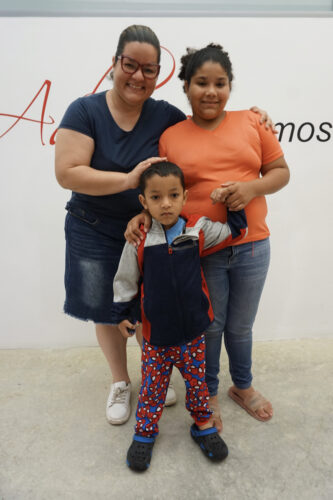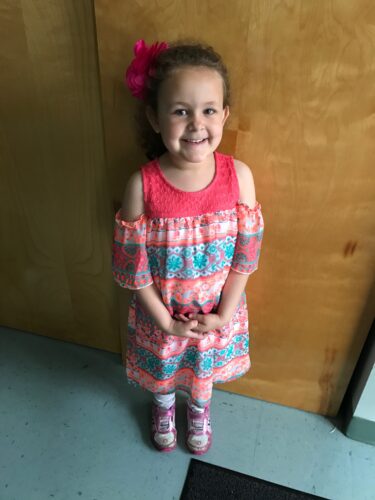After many years of planning, our first affiliated site in Puerto Rico was established and is called Iglesia Bautista de Metrópolis. Iglesia Bautista de Metrópolis is located in Carolina, and the church was created from an older congregation called Bautista Cristo Restaura, which is located in Levittown. Our sponsorship program currently serves children who live in the areas surrounding both Iglesia Bautista de Metrópolis and Bautista Cristo Restaura, but is operated under just one name.
Children have been enrolled in our sponsorship program who come mostly from the congregation’s most vulnerable families.
It all began thanks to a wonderful man named Jesus Garcia. In February 2020, I began conversations with Jesus, who at the time was the pastor of Iglesia Bautista de Metrópolis, about the possibility of an affiliation with Children Incorporated. But the start of the pandemic lockdown in March 2020 put the plan on hold. In the winter of 2020-2021, Jesus and I talked further. At that time, Jesus identified two volunteer coordinators, Marilyn and Carleen, who he felt would be great to run our sponsorship program.
Getting the program off the ground
In early 2021, the development of the coronavirus vaccine was a hopeful sign that things would get back to normal for many of us around the globe. In February of the same year, Children Incorporated sent a Hope In Action Program grant for media equipment to Iglesia Bautista de Metrópolis so that Jesus and the coordinators could reach families with information on needed resources, infection control, wellness checks, and much more. In May 2021, Children Incorporated received from the coordinators, Marilyn and Carleen, the first 20 children’s applications for enrollment. Our organization sent another Hope In Action Fund program grant to buy clothing for the children while they waited to be matched over time with sponsors.
The first year went very smoothly. The children were assigned, communication was regular, and financial reporting was received. Then, in August 2022, we learned that Jesus, who was the impetus for our affiliation, had accepted a call to move and to serve a congregation in Connecticut effective immediately. Our coordinators continued to provide for the children while the search committee reviewed and interviewed candidates. During this period, I asked the coordinators if they would be able to accommodate a visit from Children Incorporated in the spring of 2023, and they expressed pleasure at the prospect.
Getting to know Children Incorporated
Eventually the church’s search committee found the right people in its own backyard. Congregation members and married couple Ricartel and Luz Omayra were selected and hired in December 2022 as the new pastoral leadership team. They went through an orientation process to learn their new responsibilities, and Jesus told them about Children Incorporated.
In March 2023 we held a Zoom meeting with the former pastor and the new pastoral team as well as one of our coordinators, Carleen. A visit was scheduled for April 2023 with Renée Kube and Kristen Walthall, the two Children Incorporated staff members who run our U.S. Programs Department, and me. We looked forward to this visit very much.
When we arrived in April, Ricartel and Omayra picked us up at the airport in San Juan, and we started our time together with a driving tour of the area. They showed us Residencial Luis Llorens Torres, which is the largest public housing project in Puerto Rico. It opened in 1953, and it is badly showing its age. The complex goes on for block after block and is believed to be home to about 3,000 people. (There are about 325 public housing projects on the island, but this one is by far the largest.) Like virtually all public housing projects, this one is mired in generational poverty and social problems.

Our sponsorship program in Puerto Rico is helping families who are struggling to make ends meet.
There are two schools within this public housing project, and while neither is presently affiliated with Children Incorporated, there may be an opportunity to do so in the future as our outreach grows.
After the driving tour, Ricartel and Omayra took us to a restaurant for a dinner meeting with our coordinator, Carleen, who had just gotten off work and had driven to meet us. We had previously learned the other coordinator, Marilyn, could no longer continue serving. We had discussed finding a replacement for Marilyn so that Carleen would have some coverage and support.
There is truly nothing like a face-to-face meeting. Ricartel, Omayra, and Carleen are dedicated to making lives better, and they have a passion for serving. All three asked questions and developed a better understanding of our organization (especially Ricartel and Omayra, who are new to Children Incorporated).
Seeing our affiliated site
After dinner, we drove to the Carolina area where Iglesia Bautista de Metrópolis is located. It was dusk, almost full dark, and as we entered the surrounding neighborhood, Ricartel and Omayra explained it can be dangerous at night, especially for strangers. They showed us a few streets where some of our sponsored children live, but we did not get out and walk around.
Both explained they want the church to do even more outreach in the community than it has already been doing. To start, children have been enrolled in our sponsorship program who come mostly from the congregation’s most vulnerable families. This gave staff (including the pastor, the coordinator, and the bookkeeper) the chance to assess whether Children Incorporated is a reliable partner. They have been highly satisfied. Ricartel and Omayra said their inaugural outreach as pastors was a holiday visitation in the neighborhood around the church. They, along with the congregation’s families and children, strolled around, approached people, and gave the children small gifts and invitations to come to the church. They and Carleen want to enroll the children in this neighborhood without regard to whether their parents join the church, but they have to get the parents to trust them and to come to them for help. Continuing dialog is a high priority.
Then we arrived at the church where Carleen, who had driven ahead, joined us. We received a full tour of the grounds, including rooms where they’d like to hold after-school and summer programs for children. Next, we went into the building, and we were proudly taken to the area where they keep the equipment purchased with the first Hope In Action Program grant. The equipment is deeply appreciated and is used every week.
Meeting our sponsored children
Finally we got to the best part – meeting some of the children and their families. They had come to meet us, to say thank you, and to hand deliver letters for their sponsors.
Ethan, the first child we met, is five years old and will turn six in July. He was just enrolled in our sponsorship program in March, and at this time he has still not been matched with a sponsor. (However, we will be assigning him as a substitute in place of one of our 12th grade graduates.) At the time of our visit, Ethan was in kindergarten and was doing very well. He loves cartoon characters (especially Mario) and superheroes (especially Spider-Man). Ethan lives with his parents and older sister in a small house with a cement floor, cement walls, and a cement roof. His parents are responsible and loving, but their combined low wages in a bakery and a hospital do not adequately cover their expenses or provide for their children. Having a sponsor’s help with school clothing, shoes, and classroom supplies will mean a lot to Ethan.
Valeria is Ethan’s older sister. She is 12 years old, and she’s looking forward to becoming a teenager in July. She is in the seventh grade, and her favorite subject in school is family life. In her free time, she loves to draw. Valeria is excited to have a sponsor and is hopeful her little brother will be matched with a sponsor soon.
Jayden, another one of the sponsored children, is just finishing fourth grade. He loves science, drawing, and cartoons. He and his little brother, Nathan, live with their mother, a homemaker and father, a door-to-door salesman. The parents are struggling to make ends meet, and having Jayden matched with a sponsor has been a blessing.
A special moment was when I got to meet one of my sponsored children, Esteban. Esteban is 18 years old and is preparing to graduate from high school. He likes computers and loves basketball. He and his younger sister live with their single mom in a small apartment. The mom works as a nanny for very low wages. Esteban is thinking about becoming a chef but is not sure yet.
I feel Ricartel and Omayra have a good sense of our organization’s mission, and they are grateful that our sponsors and donors can provide much needed support to the children, families, and communities.
The last child we visited, George, was 10 years old at the time of our visit, and he has now turned 11. He is finishing fourth grade, where his best subject is math. George’s mom works in an accounting office, and his dad is in the U.S. Army. He is an enlisted soldier, not an officer, and his pay is low. The parents are ambitious for a better life, and they hope that soon they will no longer need outside assistance of any kind. But for now, they are glad there’s help for their son with his basic and educational needs. [NOTE: Using basic pay as the measure of military compensation, about 4.5 percent of enlisted personnel earn less than the poverty thresholds, according to the Center for Naval Analysis. Many more hover at the threshold or just above it.]
We said our goodbyes to the children and their mothers and left the church. Afterwards, we went to an administration building and had a business meeting. I went over the Specific Assistance Report, which shows all of the financial support provided by Children Incorporated from both our Hope In Action and Sponsorship Programs. Ricartel and Omayra were impressed and touched to see the impact.
Overall, this was a very successful trip. We went into the visit feeling cautiously optimistic about the new leadership, but we left enthusiastic. I feel Ricartel and Omayra have a good sense of our organization’s mission, and they are grateful that our sponsors and donors can provide much needed support to the children, families, and communities. We all also feel there is real room to grow.
***
How do I sponsor a child with Children Incorporated?
You can sponsor a child in one of three ways: call our office at 1-800-538-5381 and speak with one of our staff members; email us at sponsorship@children-inc.org; or go online to our sponsorship portal, create an account, and search for a child in that is available for sponsorship.
SPONSOR A CHILD






